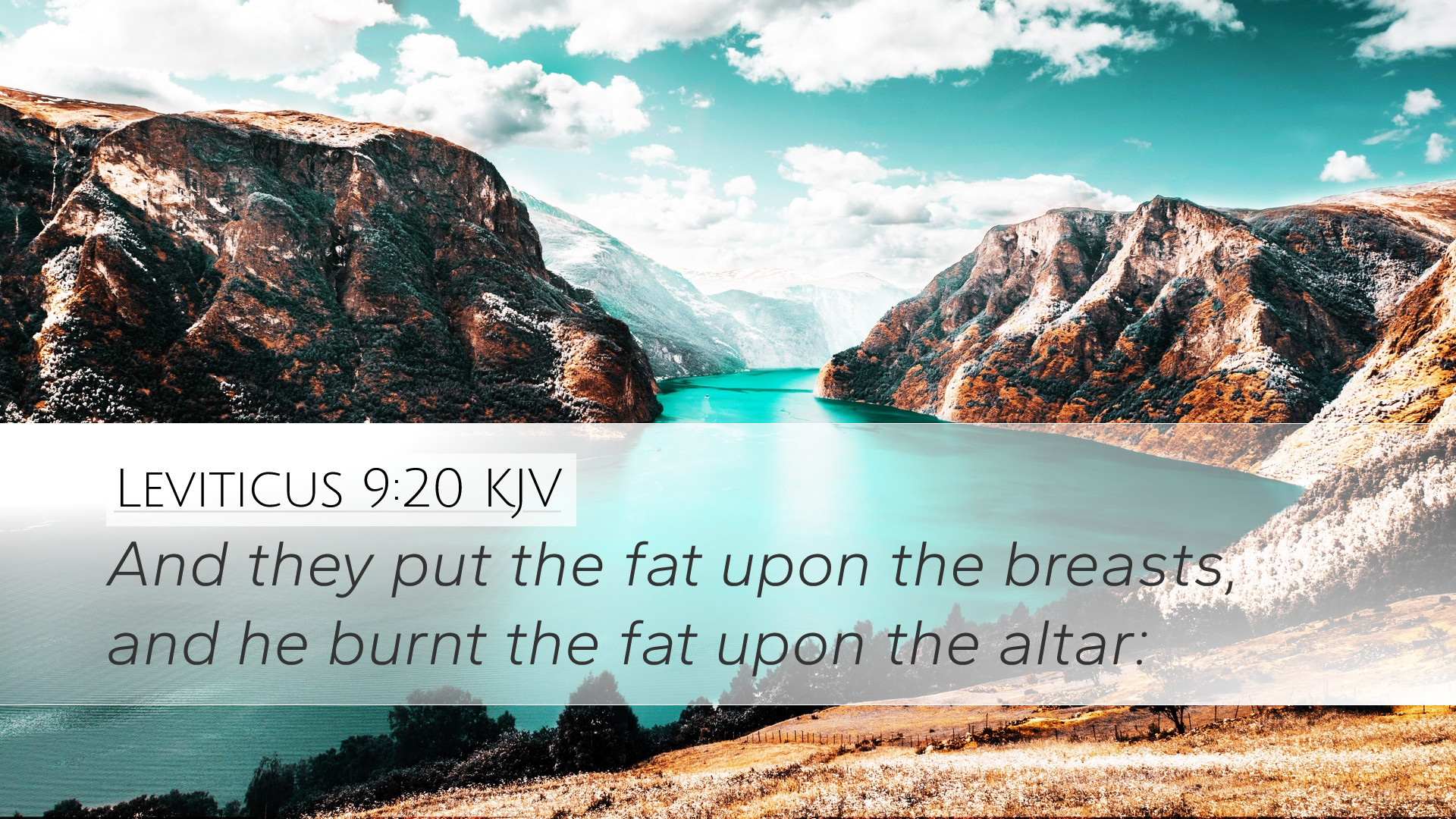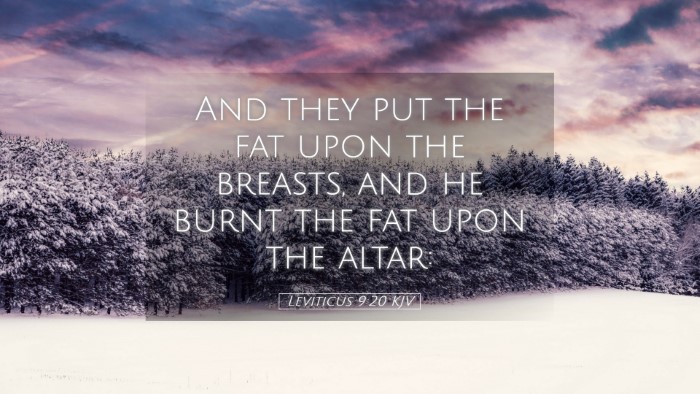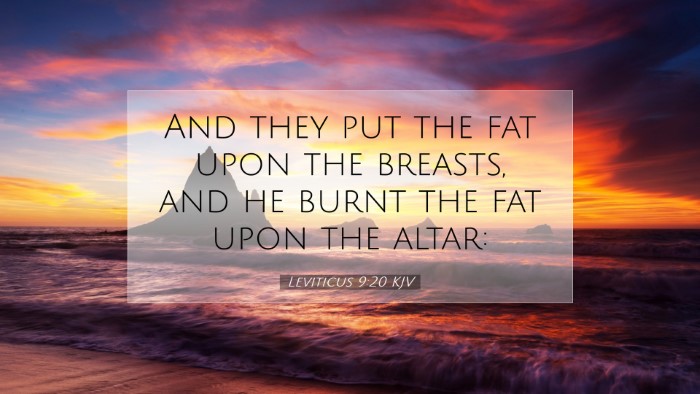Commentary on Leviticus 9:20
Leviticus 9:20 states:
"And the fat and the kidneys and the appendage of the liver from the sin offering, they placed on the breasts; and Aaron burned the fat upon the altar."
This verse captures a critical moment in the sacrificial system established in Israel, highlighting both the ceremonial and theological significance of the offerings made by Aaron as the high priest. This commentary will explore the multifaceted implications of this scripture through insights from esteemed historical commentaries.
Contextual Overview
The chapter of Leviticus 9 describes the inaugural offerings by Aaron and his sons as priests, following their consecration. This event marked a pivotal development in Israel’s worship system, establishing the role of the priest as intermediary between God and the people.
Matthew Henry's Insights
Matthew Henry highlights the importance of the sacrificial system in Israel's worship. He emphasizes that the fat, kidneys, and liver appendages represent the best parts of the animal, which were offered to God as a token of respect and honor. Henry notes:
“The greatest care was to be taken in the presentation of these offerings to show that the Lord is worthy to receive our best in worship.”
This suggests that worship must be approached with holiness and reverence, indicating that God demands the first fruits of our offerings. He also connects the act of burning the fat on the altar to the concept of holiness, for fire is often representative of God’s presence and purity in scripture.
Albert Barnes' Commentary
Albert Barnes elaborates on the specifics of the sacrificial components mentioned. He points out the significance of the various parts of the offering:
- Fat: Seen as a desirable portion, it symbolizes the abundance and richness of a sacrifice offered to God.
- Kidneys: Often associated with the innermost thoughts and intentions, indicating that genuine worship must come from a contrite heart.
- Liver Appendage: In ancient sacrifices, this part was included as a sign of the offerer’s commitment; it was believed to house vital life elements.
Barnes notes that the act of offering these parts upon the altar symbolically represents the consecration of these elements to God, suggesting a transfer of ownership from the individual to the divine. This act reflects an understanding of God’s sovereignty over life and death.
Adam Clarke's Contributions
Adam Clarke focuses on the ritual aspects and the physical actions taken by Aaron during this offering. He emphasizes that:
“The ceremonial observance was essential for the assurance of divine favor. Such actions carried profound importance, setting precedents for future generations.”
Clarke suggests that the structured process of sacrifice, including this presentation of fats and organs, communicates not only obedience but establishes a covenantal relationship with God.
Clarke also points out the significance of the altar where the burning occurs:
- The altar acts as the meeting point between humanity and divinity.
- It symbolizes the transformation of earthly offerings into spiritual worship.
- The fire of the altar represents God's acceptance of the sacrifice.
Theological Implications
This verse and the surrounding context illustrate profound theological truths about God’s character and our relationship with Him:
- God's Holiness: The meticulous nature of the sacrificial system underscores God’s holiness, revealing that He cannot be approached casually. Worship necessitates preparation, sacrifice, and a heart aligned with divine standards.
- Symbolism of Sacrifice: The offerings command the attention of worshipers, pointing to the coming perfect sacrifice in Jesus Christ, who embodies the ultimate fulfillment of the sacrificial system.
- Divine Acceptance: The act of burning the fat signifies the pleasing aroma and acceptance by God. It reassures worshipers of God’s grace and favor when they approach Him in submission and humility.
Practical Applications for Ministry
For pastors and church leaders, this passage holds several practical applications:
- Teaching about Sacrifice: Educate congregants on the importance of sacrificial giving, not just financially but in serving, time, and talents, as a demonstration of love for God and others.
- Leading in Worship: Foster an atmosphere that emphasizes heartfelt worship. Encourage authentic expressions of faith that honor God with the best of what we have.
- Reflecting on Holiness: Promote personal and corporate holiness, teaching that entering into God’s presence requires preparedness and reverence.
- Anticipating Christ: Use the sacrificial system as a teaching point to emphasize the completed work of Christ, drawing connections between Old Testament practices and New Testament grace.
Conclusion
Leviticus 9:20 not only reflects the detailed approach to worship within the Israelite tradition but also provides deeper insights into God’s nature and His desire for an intimate relationship with His people. As we draw from the wisdom of the public domain commentaries, we learn that the essence of this verse transcends history and speaks powerfully to our contemporary worship practices.
By understanding the sacrificial system, the holiness of God, and the significance of our offerings, we position ourselves to approach God with humility, sincerity, and a commitment to honor Him above all.


